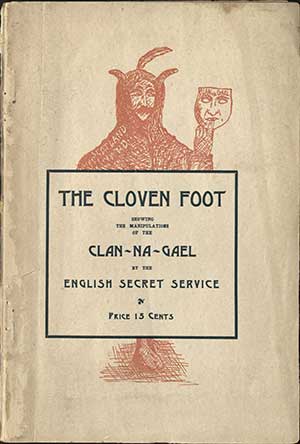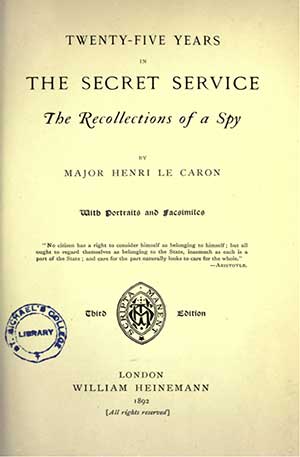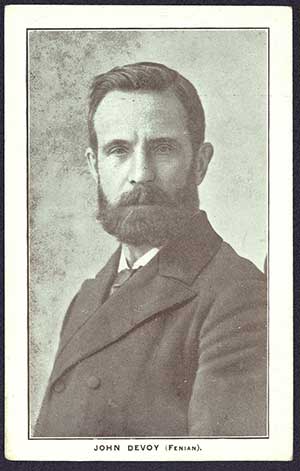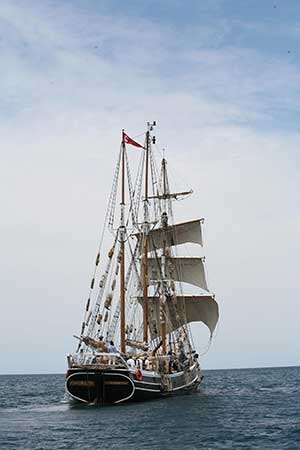‘Warfare of the dirtiest, filthiest kind’
Published in 18th-19th Century Social Perspectives, Emmigration, Features, Issue 1 (January/February 2018), Volume 26The United Irish League of America (UILA), Clan na Gael and The Cloven Foot
By Tony King

Above: The Cloven Foot, published in 1900 by the Sarsfield Publishing House, Boston, was a scathing denunciation of the leadership of the Fenian movement in Irish America. (Burns Library, Boston)
Established in New York on 4 December 1901, the United Irish League of America (UILA) was the reunited Irish Parliamentary Party’s (IPP) auxiliary organisation in the United States. Tasked with financing the constitutional movement at home, promoting the IPP across America and influencing the government in Washington to adopt policies consistent with Irish nationalist aspirations, the UILA’s performance in the decade preceding the third Home Rule crisis is worthy of admirable recognition. In their pursuit of another key objective, however, the unification of all existing Irish-American organisations under the umbrella of moderation, the League was notably less successful.
While a significant number of the rank-and-file membership of the more extreme Clan na Gael were willing to embrace John Redmond’s new organisation, the leader of the physical-force party, John Devoy, determined to broker no alliance with the apostles of parliamentary reform. Having denounced the constitutional party for its role in facilitating the Wyndham Land Act of 1903, Devoy’s animosity to its American affiliate reached new heights in 1904, when he charged individual UILA officials with defaming the Fenian movement in America. To sustain this charge, Devoy cited a controversy-laden pamphlet, The Cloven Foot, and the role he believed the UILA played in its dissemination.

Above: Twenty-five years in the secret service—the title-page of Henri Le Caron’s 1892 autobiography was used by Daniel Dwyer to support many of The Cloven Foot’s more contentious claims.
The Cloven Foot
Subsequently attributed to a Daniel Dwyer, The Cloven Foot was an anonymously authored 43-page pamphlet published by the Sarsfield Publishing House, High Street, Boston, in 1900. Its subtitle—Showing the manipulations of the Clan na Gael by the English secret service—gives a clear indication of the hostile reception that such a publication was bound to elicit among certain members of the nationalist tradition in Irish America. The author claimed that
‘Clan na Gael were being used as an engine of destruction to the Irish cause in every possible way; that all the necessary evidence was at hand to show that the Clan’s policy, as outlined by their secret executives, had always been opposed to the nationalist cause; that Fenianism itself was victimised by the betrayers; and that the Clan was and continued to be [victimised] to the present day.’
With repeated references to the testimony of the self-confessed British agent Henri Le Caron at the Special Commission on Parnellism and Crime held in 1888–9 and to Le Caron’s autobiography, published in 1892, The Cloven Foot ridiculed the notion that there was not a single spy in the entire body of Clan na Gael.
Dwyer used the admission of Le Caron’s involvement with the Clan leadership for a quarter of a century to pour scorn on the notion that the British authorities did not have prior knowledge of the rescue of six Irish political prisoners from Western Australia in 1876 aboard the whaling ship Catalpa. In referencing another popular biography of the period—James Jeffrey Roche’s account of the life of John Boyle O’Reilly—the pamphlet alleged that Scotland Yard could not but have known about the escape plot, and that their decision to allow the rescue to proceed was taken with the express intent of deluding the Clan into believing that they were entirely free from infiltration. The Cloven Foot also castigated the Clan for bringing ruin upon the Land League in 1881; for failing in its attempt to capture the American branch of the Irish National League in 1886; and for passing a resolution at the subsequent Clan convention purposefully designed to give the false impression of an alliance on paper between the extreme wing of the nationalist movement and Parnell’s new organisation. This resolution, Dwyer alleged, was later used by the Crown Prosecution in an effort to entrap Parnell at the aforementioned Special Commission in 1889. The pamphlet concluded with a note of caution to the Ancient Order of Hibernians in America to beware of Clan efforts to conduct a take-over of their organisation in the not-too-distant future, a prescient observation which, it could be argued, came to fruition during the presidency of Matthew Cummings (1906–10).
Author’s motivation

Above: John Devoy—in 1904 he charged UILA officials with defaming the Fenian movement in America, citing The Cloven Foot as evidence.
Dwyer characterised his decision to publish The Cloven Foot as one born out of a sense of national duty. Accusing British publishing houses of rejecting his work for fear of retribution by the British secret service, the author alluded to the inflammatory nature of the pamphlet’s content as the reason for the Irish-American press following suit. Challenging the Irish World, the Chicago Citizen and the Boston Pilot to refute his claims, Dwyer promised a full retraction if evidence to the contrary could be provided.
The reason The Cloven Foot surfaced as an issue in 1904 is because John Devoy, through the pages of his own newspaper, the Gaelic American, openly charged the UILA with actively disseminating the pamphlet as part of a concerted campaign to discredit the Clan. On 16 July the Clan chief derided John Redmond for denying any knowledge of The Cloven Foot when he himself claimed to have sent a copy of it to the IPP chairman. Devoy also maintained that officers of the UILA were not only guilty of championing the toxic pamphlet but were ‘holding it up under the noses of Clan na Gael men and asking them what they thought of it, inviting them into their homes to look at it, and pouring forth the lies it contained at meetings of UILA branches across the country’. The Gaelic American editorial even went so far as to call Redmond’s denial of any knowledge of the offending text ‘as futile as a similar claim made by John O’Callaghan’, secretary of the UILA. By September Devoy felt confident enough to publish the names of the 28 UILA officials to whom he had referred in July, and accused the League of ‘conducting warfare of the dirtiest, filthiest kind in John Redmond’s name’. Unsurprisingly, this climate of almost rabid hostility directed towards the UILA ensured that any prospect of diasporic harmony between the moderate and extreme elements of nationalist Irish America remained beyond the remit of the IPP’s US affiliate.

Above: The whaling ship Catalpa, as depicted by RTÉ’s ‘Hidden History’ documentary on the subject broadcast in autumn 2007. Dwyer used the admission of Le Caron’s involvement with the Clan leadership to pour scorn on the notion that the British authorities did not have prior knowledge of the rescue of six Irish political prisoners from Western Australia in 1876. (Crossing the Line Films)
Fenian indignation
With regard to The Cloven Foot it matters little whether the UILA actually colluded in the pamphlet’s dissemination; what mattered was that Devoy believed that they did. Nor does Dwyer’s over-reliance on the testimony of a British agent skilled in the art of deception dilute the pamphlet’s impact, as its content provides an all-too-convincing narrative for anyone prepared to read it with an open mind. Moreover, the absence of any official denunciation of The Cloven Foot from any League or Party platform could readily be interpreted as tacit approval of the controversial publication. No refutation of association with the pamphlet was made in the speeches delivered at the second national convention of the UILA held in New York on 30–31 August 1904, and if indeed the League did play their part in casting derogatory aspersions on the Fenian movement the benefits to be accrued from such a policy are plain to see. From the simple inference that the majority of the Clan rank and file were the inadvertent dupes of Scotland Yard it could be assumed that an exodus of members from a largely discredited organisation to one which could lay claim to being the natural successor to Parnell’s movement would ensue. As to what extent this occurred we can only speculate. That Devoy and his movement suffered serious reputational damage on the back of the pamphlet’s publication requires a somewhat smaller leap of faith.
Conclusion
While the subject of British infiltration of Irish revolutionary organisations has been recognised, surprisingly few references to this controversial pamphlet appear to exist. The fact that Le Caron featured so sparingly in Devoy’s Post Bag, Vol. II, that he did not feature at all in Recollections of an Irish rebel and that there was no mention of The Cloven Foot in either may account for much of this neglect. With regard to the rescue of the Fenian prisoners off Western Australia aboard the Catalpa, Devoy’s Recollections simply recalled that ‘matters relating to the rescue subsequently became subjects of controversy; they received a lot of publication, so I need not repeat them here’. Yet Devoy’s understandable reluctance to revisit events should not serve to diminish the impact the controversy had at the time. Nor should it deflect us from revisiting it today. Maybe it was post-independence Ireland’s near-deification of the Clan leader as a true patriot or the absence of incontrovertible proof to support Dwyer’s contentious claims that were responsible for the controversial text’s fading into subsequent oblivion? These remain matters of personal opinion. Nevertheless, as evidence of an enduring dissension between the different strands of the nationalist community at a critical juncture in the diaspora’s history, The Cloven Foot should be afforded a greater relevance.
Tony King is a Ph.D student in history at NUI Galway.
FURTHER READING
M. Campbell, Ireland’s new worlds: immigrants, politics and society in the United States and Australia, 1815–1922 (Madison, 2007).
F.M. Carroll, American opinion and the Irish question, 1910–23 (Dublin, 1978).
J. Lee & M.R. Casey (eds), Making the Irish American: history and heritage of the Irish in the United States (New York, 2006).
A.J. Ward, Ireland and Anglo-American relations, 1899–1921 (London, 1969).
















